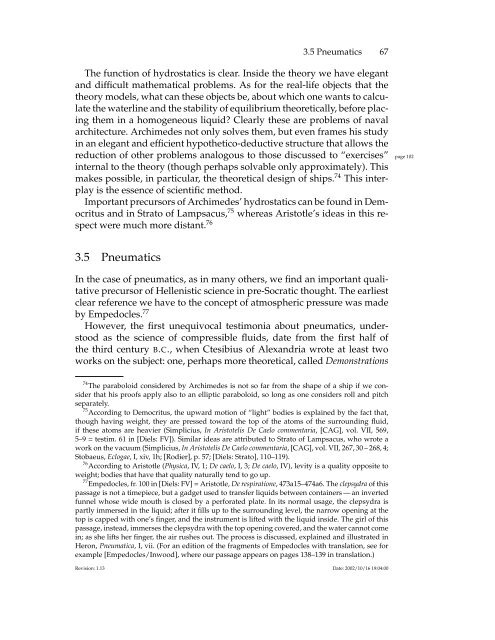1 The Birth of Science - MSRI
1 The Birth of Science - MSRI
1 The Birth of Science - MSRI
You also want an ePaper? Increase the reach of your titles
YUMPU automatically turns print PDFs into web optimized ePapers that Google loves.
3.5 Pneumatics 67<br />
<strong>The</strong> function <strong>of</strong> hydrostatics is clear. Inside the theory we have elegant<br />
and difficult mathematical problems. As for the real-life objects that the<br />
theory models, what can these objects be, about which one wants to calculate<br />
the waterline and the stability <strong>of</strong> equilibrium theoretically, before placing<br />
them in a homogeneous liquid? Clearly these are problems <strong>of</strong> naval<br />
architecture. Archimedes not only solves them, but even frames his study<br />
in an elegant and efficient hypothetico-deductive structure that allows the<br />
reduction <strong>of</strong> other problems analogous to those discussed to “exercises” page 102<br />
internal to the theory (though perhaps solvable only approximately). This<br />
makes possible, in particular, the theoretical design <strong>of</strong> ships. 74 This interplay<br />
is the essence <strong>of</strong> scientific method.<br />
Important precursors <strong>of</strong> Archimedes’ hydrostatics can be found in Democritus<br />
and in Strato <strong>of</strong> Lampsacus, 75 whereas Aristotle’s ideas in this respect<br />
were much more distant. 76<br />
3.5 Pneumatics<br />
In the case <strong>of</strong> pneumatics, as in many others, we find an important qualitative<br />
precursor <strong>of</strong> Hellenistic science in pre-Socratic thought. <strong>The</strong> earliest<br />
clear reference we have to the concept <strong>of</strong> atmospheric pressure was made<br />
by Empedocles. 77<br />
However, the first unequivocal testimonia about pneumatics, understood<br />
as the science <strong>of</strong> compressible fluids, date from the first half <strong>of</strong><br />
the third century B.C., when Ctesibius <strong>of</strong> Alexandria wrote at least two<br />
works on the subject: one, perhaps more theoretical, called Demonstrations<br />
74 <strong>The</strong> paraboloid considered by Archimedes is not so far from the shape <strong>of</strong> a ship if we consider<br />
that his pro<strong>of</strong>s apply also to an elliptic paraboloid, so long as one considers roll and pitch<br />
separately.<br />
75 According to Democritus, the upward motion <strong>of</strong> “light” bodies is explained by the fact that,<br />
though having weight, they are pressed toward the top <strong>of</strong> the atoms <strong>of</strong> the surrounding fluid,<br />
if these atoms are heavier (Simplicius, In Aristotelis De Caelo commentaria, [CAG], vol. VII, 569,<br />
5–9 = testim. 61 in [Diels: FV]). Similar ideas are attributed to Strato <strong>of</strong> Lampsacus, who wrote a<br />
work on the vacuum (Simplicius, In Aristotelis De Caelo commentaria, [CAG], vol. VII, 267, 30 – 268, 4;<br />
Stobaeus, Eclogae, I, xiv, 1h; [Rodier], p. 57; [Diels: Strato], 110–119).<br />
76 According to Aristotle (Physica, IV, 1; De caelo, I, 3; De caelo, IV), levity is a quality opposite to<br />
weight; bodies that have that quality naturally tend to go up.<br />
77 Empedocles, fr. 100 in [Diels: FV] = Aristotle, De respiratione, 473a15–474a6. <strong>The</strong> clepsydra <strong>of</strong> this<br />
passage is not a timepiece, but a gadget used to transfer liquids between containers — an inverted<br />
funnel whose wide mouth is closed by a perforated plate. In its normal usage, the clepsydra is<br />
partly immersed in the liquid; after it fills up to the surrounding level, the narrow opening at the<br />
top is capped with one’s finger, and the instrument is lifted with the liquid inside. <strong>The</strong> girl <strong>of</strong> this<br />
passage, instead, immerses the clepsydra with the top opening covered, and the water cannot come<br />
in; as she lifts her finger, the air rushes out. <strong>The</strong> process is discussed, explained and illustrated in<br />
Heron, Pneumatica, I, vii. (For an edition <strong>of</strong> the fragments <strong>of</strong> Empedocles with translation, see for<br />
example [Empedocles/Inwood], where our passage appears on pages 138–139 in translation.)<br />
Revision: 1.13 Date: 2002/10/16 19:04:00










